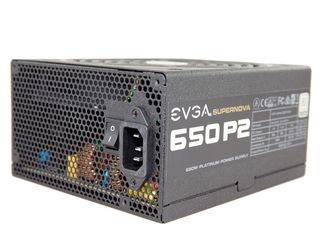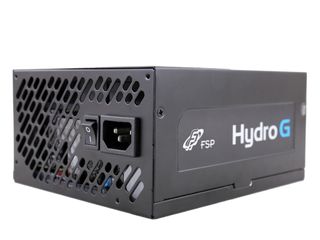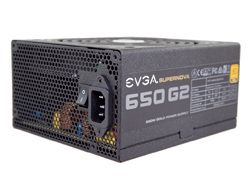Seasonic Prime Titanium 650W PSU Review
Seasonic jumps onto the 80 PLUS Titanium wagon with three new units that belong to its Prime family. The 650 W model is under our scope today. Besides high efficiency, it also offers great performance, quiet operation, and nice looks.
Why you can trust Tom's Hardware
Load Regulation, Hold-Up Time, And Inrush Current
To learn more about our PSU tests and methodology, please check out How We Test Power Supply Units.
Primary Rails And 5VSB Load Regulation
Load Regulation testing is detailed here.








Hold-Up Time
Our hold-up time tests are described in detail here.







This hold-up time result is the longest that we have ever measured. Seasonic wasn't joking with its >30 ms hold-up time claim, that's for sure.
Inrush Current
For details on our inrush current testing, please click here.


The inrush current is higher than normal due to the higher-capacity bulk caps.
Load Regulation And Efficiency Measurements
This first set of tests reveals the stability of the voltage rails, along with the PSU's efficiency. The applied load equals (approximately) 10 to 110 percent of the maximum load the supply can handle, in increments of 10 percentage points.
We conducted two additional tests. During the first, we stressed the two minor rails (5V and 3.3V) with a high load, while the load at +12V was only 0.1 A. This test reveals whether a PSU is Haswell-ready or not. In the second test, we determined the maximum load the +12V rail could handle with minimal load on the minor rails.
| Test # | 12V | 5V | 3.3V | 5VSB | DC/AC (Watts) | Efficiency | Fan Speed | Fan Noise | Temps (In/Out) | PF/AC Volts |
|---|---|---|---|---|---|---|---|---|---|---|
| 1 | 3.523A | 1.995A | 1.983A | 1.000A | 64.72 | 90.94% | 490 RPM | 21.2 dB(A) | 39.33 °C | 0.957 |
| 12.247V | 5.009V | 3.324V | 4.991V | 71.17 | 40.81 °C | 115.2V | ||||
| 2 | 8.075A | 2.991A | 2.976A | 1.199A | 129.70 | 93.21% | 490 RPM | 21.2 dB(A) | 39.32 °C | 0.982 |
| 12.242V | 5.008V | 3.323V | 4.989V | 139.15 | 40.91 °C | 115.2V | ||||
| 3 | 12.968A | 3.499A | 3.492A | 1.400A | 194.79 | 93.57% | 490 RPM | 21.2 dB(A) | 39.75 °C | 0.989 |
| 12.238V | 5.007V | 3.319V | 4.985V | 208.18 | 41.52 °C | 115.2V | ||||
| 4 | 17.954A | 3.996A | 3.640A | 1.604A | 259.72 | 94.16% | 490 RPM | 21.2 dB(A) | 40.45 °C | 0.996 |
| 12.234V | 5.005V | 3.319V | 4.981V | 275.83 | 42.51 °C | 115.2V | ||||
| 5 | 22.419A | 4.991A | 4.969A | 1.805A | 324.62 | 93.42% | 490 RPM | 21.2 dB(A) | 41.50 °C | 0.993 |
| 12.229V | 5.004V | 3.319V | 4.980V | 347.49 | 43.85 °C | 115.2V | ||||
| 6 | 26.986A | 5.996A | 5.966A | 2.004A | 389.64 | 93.04% | 400 RPM | 18.2 dB(A) | 42.95 °C | 0.991 |
| 12.224V | 5.003V | 3.317V | 4.979V | 418.80 | 45.87 °C | 115.1V | ||||
| 7 | 31.546A | 7.003A | 6.965A | 2.207A | 454.60 | 92.59% | 480 RPM | 20.3 dB(A) | 43.17 °C | 0.992 |
| 12.220V | 5.002V | 3.316V | 4.977V | 491.00 | 47.15 °C | 115.1V | ||||
| 8 | 36.115A | 8.003A | 7.965A | 2.410A | 519.55 | 92.05% | 495 RPM | 20.8 dB(A) | 43.99 °C | 0.993 |
| 12.215V | 5.000V | 3.314V | 4.976V | 564.41 | 48.45 °C | 115.1V | ||||
| 9 | 41.114A | 8.503A | 8.481A | 2.409A | 584.56 | 91.56% | 555 RPM | 23.5 dB(A) | 44.53 °C | 0.994 |
| 12.209V | 4.999V | 3.313V | 4.978V | 638.48 | 49.39 °C | 115.2V | ||||
| 10 | 45.865A | 9.013A | 8.967A | 3.019A | 649.47 | 90.99% | 670 RPM | 28.3 dB(A) | 45.47 °C | 0.995 |
| 12.204V | 4.998V | 3.312V | 4.965V | 713.79 | 50.78 °C | 115.2V | ||||
| 11 | 51.217A | 9.013A | 8.968A | 3.019A | 714.41 | 90.48% | 700 RPM | 30.9 dB(A) | 46.68 °C | 0.996 |
| 12.197V | 4.996V | 3.312V | 4.964V | 789.54 | 52.57 °C | 115.2V | ||||
| CL1 | 0.098A | 12.012A | 12.005A | 0.000A | 101.13 | 88.59% | 495 RPM | 20.8 dB(A) | 46.11 °C | 0.979 |
| 12.251V | 5.004V | 3.317V | 5.064V | 114.15 | 49.92 °C | 115.2V | ||||
| CL2 | 54.114A | 1.003A | 1.003A | 1.001A | 673.03 | 91.38% | 670 RPM | 28.3 dB(A) | 47.05 °C | 0.995 |
| 12.191V | 5.002V | 3.308V | 4.983V | 736.56 | 51.25 °C | 115.1V |
Load regulation on all major rails is within 0.5 percent, as Seasonic promises. This is jaw-dropping performance that'll force the competition to push their engineering teams harder to catch up. Normally, very high efficiency levels suffer the side effect of loose load regulation since fewer components are used to minimize energy losses. Somehow Seasonic's engineers found a way to overcome this problem. At the same time, excellent load regulation results on the minor rails (including 5VSB) are obtained only with the use of an extra ATX cable that Seasonic provides. It has extra sense wires, though which we can directly measure the voltage levels on the 5V and 3.3V rails. It seems as though the SSR-650TD's normal bundled cable has loose pins; load regulation on the minor rails (again, including 5VSB) was above 1 percent with it. We notified Seasonic about this problem and its engineers are looking into it.
The efficiency this unit achieves is nothing less than amazing. Under 10 percent load, it easily surpasses the 90% mark. The same goes for our 20 percent and full load tests. Only under the middle load does the SSR-650TD fail to hit its required 94% efficiency level. Then again, the 80 PLUS organization certifies PSUs at a much lower ambient temperature than we do, allowing for higher efficiency levels. It is rare to see a PSU delivering 93.42 percent efficiency under mid-load at an ambient temperature above 40 °C.
Seasonic's fan curve is rather strange. With its start-up voltage of 2.5 V, the fan spins at 490 RPM. At slightly higher voltage (in the 3.2 to 3.6 V range), we get fewer RPM instead of the higher measurement we'd expect. The results were verified our results multiple times using both a scope and a digital tachometer. At least the fan's noise is super low. Even with the PSU delivering 110 percent of its max-rated capacity at 47 °C, our readings are close to 30 dB(A). The semi-passive mode doesn't last as long as Super Flower's Titanium-rated platforms, though we strongly believe that this is preferable since it doesn't allow the build-up of high temperatures inside of the PSU.
Current page: Load Regulation, Hold-Up Time, And Inrush Current
Prev Page A Look Inside And Component Analysis Next Page Efficiency, Temperature And NoiseStay on the Cutting Edge
Join the experts who read Tom's Hardware for the inside track on enthusiast PC tech news — and have for over 25 years. We'll send breaking news and in-depth reviews of CPUs, GPUs, AI, maker hardware and more straight to your inbox.
Aris Mpitziopoulos is a Contributing Editor at Tom's Hardware US, covering PSUs.
-
bharatwd 60 Ampere of inrush current is too high for 230 V countries. Wont that damage the other parts in the pc?Reply -
Aris_Mp It won't damage anything in the PC since it doesn't have to do anything with the PSU's secondary side. High inrush currents apply stress to the electrical infrastructure (switches, relays etc.)Reply -
bharatwd Hi Aris, thanks for the reply..............So it will basically hurt the PSU components itself?Reply -
turkey3_scratch My mind is blown. This is a great unit and I'm happy to see the transient response performance was good. HardOCP's testing on one of the Prime Titanium units shows not-so-good transient response performance.Reply
Whoops accidental upvote above. -
Aris_Mp Nope it won't hurt the PSU, just the breakers and electrical circuits before it will be stressed a bit.Reply
Haswell ready: I was thinking to change this to S6/S7 compatible. Probably the time has come for this to happen. -
bharatwd Thanks for the reply Aris........10 years warranty will be fun if the current inrush is at 60+ Ampere :) especially in India :)Reply -
Virtual_Singularity Excellent review. Impressive work/effort by Seasonic as well. Curious to see how the other units in this new line stack up to this one. Haven't seen HOCP's review yet, but there has been some variance in others, but still seems like a solid effort on Seasonic's part.Reply
With no capacitors in the cables, can't see a reason not to flatten the atx connector as well. I guess the sleeved atx connect look has become somewhat traditional. Not a criticism by any means, just saying. -
turkey3_scratch Reply18563170 said:Excellent review. Impressive work/effort by Seasonic as well. Curious to see how the other units in this new line stack up to this one. Haven't seen HOCP's review yet, but there has been some variance in others, but still seems like a solid effort on Seasonic's part.
With no capacitors in the cables, can't see a reason not to flatten the atx connector as well. I guess the sleeved atx connect look has become somewhat traditional. Not a criticism by any means, just saying.
On Jonnyguru Oklahomawolf likes the ATX cable to be sleeved and the others to be ribbon; this is because 24 wires can sometimes become difficult to manage in ribbon style versus sleeved. That's just his thinking at least, and I sort of understand where he comes from with that. If it's ribbon style that also makes it an extremely wide cable, whereas if it is sleeved it's more narrow for better cable routing and then widens up at the end. -
JackNaylorPE I find round sleeved cables much more difficult to manage, and the reason why many builders sleeve there own cables or use extensions. OTOH, the plain flat cables are just fugly, you can get the best of both worlds with flat, individually sleeved cables. Individually sleveed cables, with cable combs, offer the optimal combination of aesthetic choice and easier cable routing.Reply
I don't really understand the big "ooh wow" about Titanium rates PSUs; all it is is a "green" energy consumption rating and unless you pay well above the average US utility costs, you'll never get a positive ROI. What I don't understand is why "PSUs and cables" aren't offered as a "bundle". I hate paying a quality set of cable and then leaving them in a box. I'd like to see some PSU manufacturer "step up" and and say offer every PSU with a $xx coupon for a set of cables. The value of the coupon would cover the basic cable set so it would essentially come free with the PSU. OTOH, if you wanted to move up to a, individually sleeved set, you would only have to pay the difference between the base set and the set of your choice
http://www.frozencpu.com/products/18823/psu-cab-50/Corsair_Professional_Series_Individually_Sleeved_DC_Modular_Cable_Kit_Type_3_Generation_2_-_White_CP-8920050.html?tl=g2c413s1599


